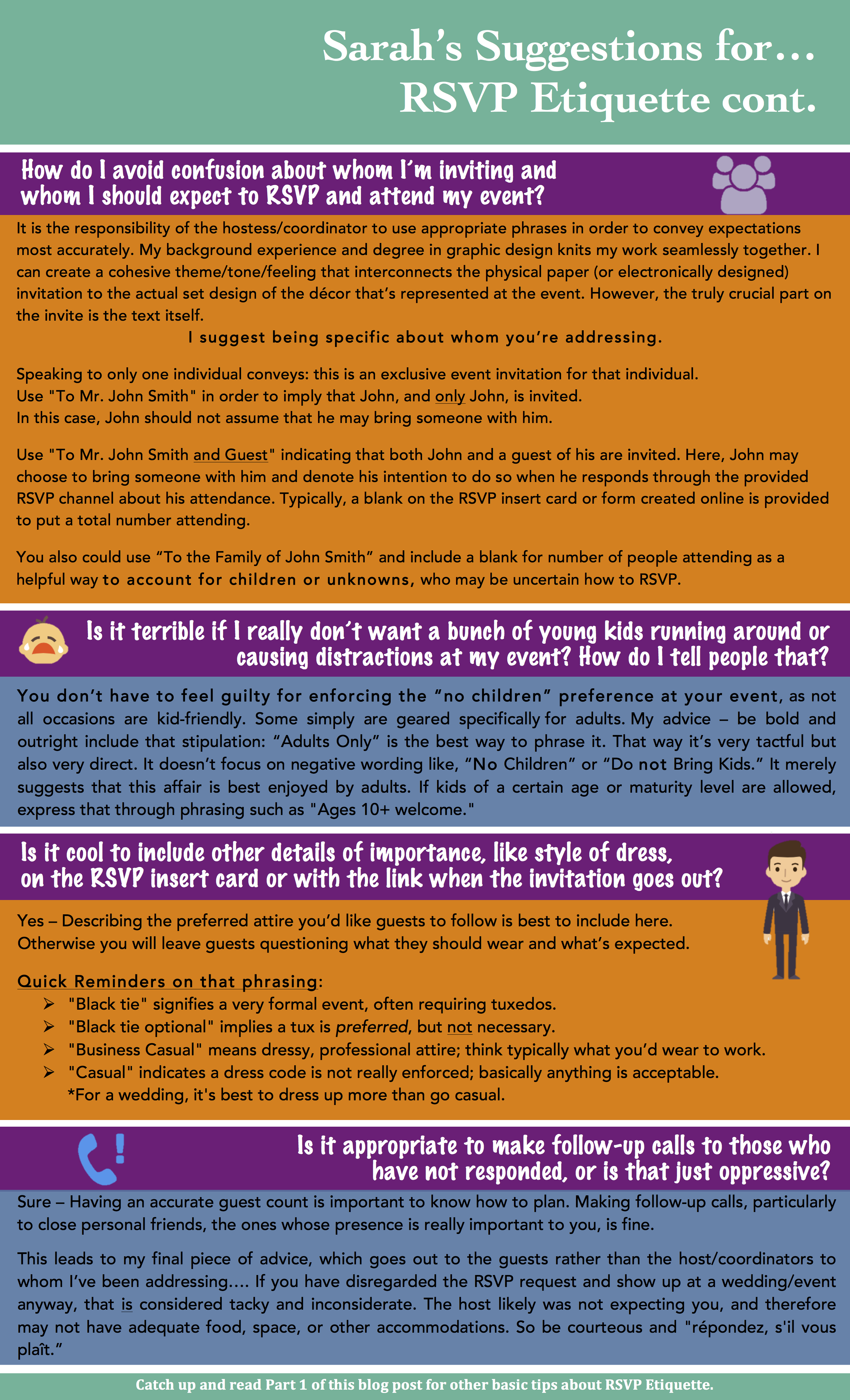To continue with some tips surrounding RSVP etiquette and build upon my last post as promised, let me remind you that no matter how great the invitation looks, how creatively designed the RSVP card or online form is, or even how perfectly timed it is sent/received, the devil is in the details – the wording.
So here are some additional FAQs about such particulars and my suggestions on what works best…

- How do I avoid confusion about whom I’m inviting and whom I should expect to RSVP and attend my event?
It is the responsibility of the hostess/coordinator to use appropriate phrases in order to convey expectations most accurately. My background experience and degree in graphic design knits my work seamlessly together. I can create a cohesive theme/tone/feeling that interconnects the physical paper (or electronically designed) invitation to the actual set design of the décor that’s represented at the event. However, the truly crucial part on the invite is the text itself.
I suggest being specific about whom you’re addressing.
Speaking to only one individual conveys: this is an exclusive event invitation for that individual.
Use “To Mr. John Smith” in order to imply that John, and only John, is invited.
In this case, John should not assume that he may bring someone with him.*
Use “To Mr. John Smith and Guest” indicating that both John and a guest of his are invited. Here, John may choose to bring someone with him and denote his intention to do so when he responds through the provided RSVP channel about his attendance.
Typically, a blank on the RSVP insert card or form created online is provided to put a total number attending.
You also could use “To the Family of John Smith” and include a blank for number of people attending as a helpful way to account for children or unknowns, who may be uncertain how to RSVP.
- Is it terrible if I really don’t want a bunch of young kids running around or causing distractions at my event? How do I tell people that?
You don’t have to feel guilty for enforcing the “no children” preference at your event, as not all occasions are kid-friendly. Some simply are geared specifically for adults. My advice – be bold and outright include that stipulation: “Adults Only” is the best way to phrase it. That way it’s very tactful but also very direct. It doesn’t focus on negative wording like, “No Children” or “Do not Bring Kids.” It merely suggests that this affair is best enjoyed by adults. If kids of a certain age or maturity level are allowed, express that through phrasing such as “Ages 10+ welcome.”
- Is it cool to include other details of importance, like style of dress, on the RSVP insert card or with the link when the invitation goes out?
Yes – Describing the preferred attire you’d like guests to follow is best to include here. Otherwise you will leave guests questioning what they should wear and what’s expected.
Quick Reminders on that language:
- “Black tie” signifies a very formal event, often requiring tuxedos.
- “Black tie optional” implies a tux is preferred, but not
- “Business Casual” means dressy, professional attire; think typically what you’d wear to work.
- “Casual” indicates a dress code is not really enforced; basically anything is acceptable.
*For a wedding, it’s best to dress up more than go casual.
- Is it appropriate to make follow-up calls to those who have not responded, or is that just oppressive?
Sure – Having an accurate guest count is important to know how to plan. Making follow-up calls, particularly to close personal friends, the ones whose presence is really important to you, is fine.
This leads to my final piece of advice, which goes out to the guests rather than the host/coordinators to whom I’ve been addressing…. If you have disregarded the RSVP request and show up at a wedding/event anyway, that is considered tacky and inconsiderate. The hosts likely were not expecting you and therefore may not have food, space or other accommodations. So be courteous and “répondez, s’il vous plaît.”
Once again those are my suggestions – what are yours? Any extra pointers or other considerations?

